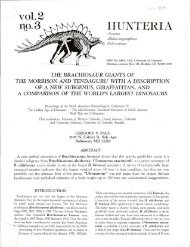THE MANY MYTHS, SOME OLD, SOME NEW, OF ... - Gregory S. Paul
THE MANY MYTHS, SOME OLD, SOME NEW, OF ... - Gregory S. Paul
THE MANY MYTHS, SOME OLD, SOME NEW, OF ... - Gregory S. Paul
Create successful ePaper yourself
Turn your PDF publications into a flip-book with our unique Google optimized e-Paper software.
82 . G. S.·PAUL<br />
Reality: As usual, life is not so simple (Figure 6; <strong>Paul</strong>, 1990a). nina and leatherbacks<br />
are very active, fast swimmers with metabolic rates in the lower mammal range, and<br />
very high rates of food consumption. Yet their brains are small-and simple.<br />
Pterosaurs were highly active, insulated fliers that must have had elevated metabolic<br />
rates, and although their brains were fairly complex, their EQ's fall entirely within<br />
the reptile range (Figure 7). At the other extreme, some advanced rays are inactive<br />
and bradymetabolic bottom dwellers with brains as large-as those of felids,canids,<br />
and ungulates of similar size (Northcutt, 1977). Reef and hammerhead sharks are<br />
bradytherms whose brains are as large as those of ground birds of similar size, and<br />
that have enlarged, complex forebrains.<br />
The overlap between vertebrates with differing brain sizes and physiologies is so<br />
extensive that their traditional segregation into "lower" and "higher" vertebrates<br />
must be considered obsolete. Brain size and complexity does not have any consistent<br />
correlation with metabolic rates or activity levels, and cannot be used to determine<br />
dinosaur physiology at even the gross or detailed levels. It is widely acknowledged<br />
that small brained dinosaur species were often social and parental (Horner and<br />
Gorman, 1988; Coombs, 1989), if sovthen they were intelligent enough to have<br />
maintained a high level of energy consumption and production. Note that small<br />
brains in highly energetic dinosaurs does not violate the evolutionary trend towards<br />
increased information processing (see above). In addition to the higher rate of<br />
generational inspired genetic turnover, the higher feeding rates of endotherms<br />
require an order of magnitude increase in the frequency of brain activity in order to<br />
achieve the levels of activity needed to search for and consume the food. Small<br />
brained ants, bees and termites have also achieved a similar boost in information<br />
processing, in their case via intense socialization.<br />
BRADYMETABOLIC DINOSAURS COULD GROW UP FAST<br />
Myth: It is now widely acknowledged that many or all dinosaurs grew as fast as<br />
tachymetabolic mammals and birds, which grow 10 to 30 times faster than wild<br />
bradymetabolic reptiles. Since many of these workers also believe that dinosaurs<br />
combined double pump hearts with reptilian energetics, they argue that nontachymetabolic<br />
animals can also grow rapidly (Ricqles, 1980; Regal and Gans, 1980;<br />
Reid, 1984, 1987; Dunham et al., 1989).<br />
Reality: This emerging myth badly needs nipping in the bud. For a free living,<br />
self feeding juvenile to grow fast, it must have very high sustained activity levels in<br />
order to find the abundant amounts of food needed to grow so rapidly, and the little<br />
creature must remain warm around the clock in order to maintain continuous<br />
growth. Both of these needs require the hyper-elevated energy levels (one third over<br />
the mass specific adult level) seen in juvenile mammals and birds (Case, 1978). That<br />
captive reptiles can grow much faster than their free-living counterparts only<br />
reinforces the factthat they must have food brought to them in order to do so; they<br />
cannot acquire enough food on their own. Excellent confirmation of the correlation<br />
linking metabolisms and maximum potential growth rates is found in the fact that<br />
land animals with intermediate metabolic rates, marsupials and monotremes, grow<br />
at rates intermediate to placentals and reptiles. Note that the only fast growing<br />
reptile, the leatherback, is a highly energetic swimmer with low locomotary energy<br />
costs. It is hardly likely that fossil animals somehow broke these barriers. Equally<br />
unlikely is that, if it is possible for low energy land animals to grow fast, not a









